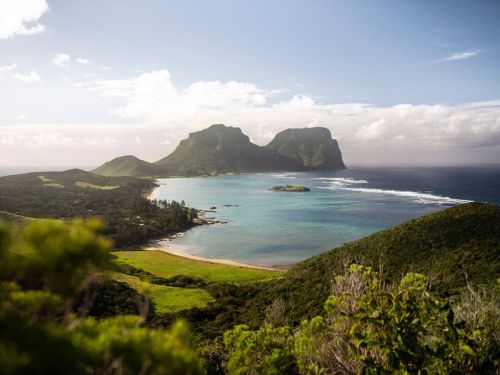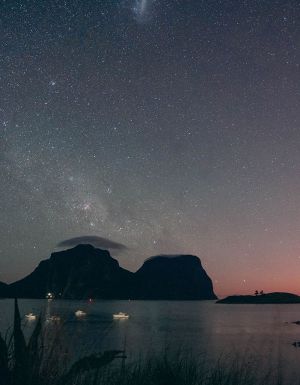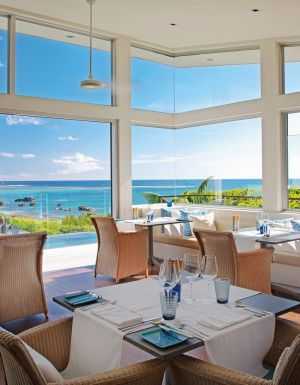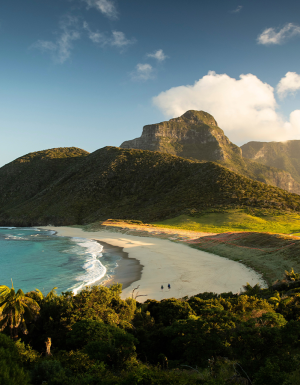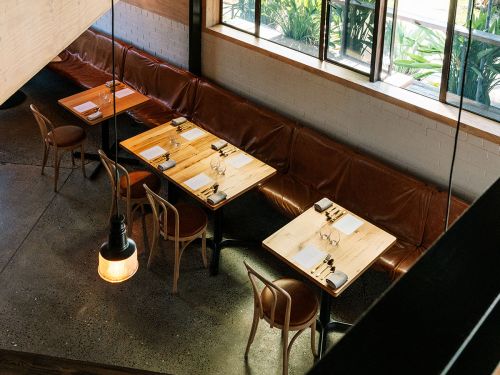Whether you’d like to test your mettle or adopt an unhurried pace, these are the best walks and hikes for discovering the beauty of Lord Howe Island.
Looming from the sea as if a mirage, the UNESCO World Heritage Lord Howe Island easily evades comparison to any other island. Fringed by impossibly clear, cyan-hued waters and with lush sub-tropical forests draped over soaring mountains, it offers some of the most dramatic and beautiful terrain in Australia.
With heart-snatching views, adrenalin-spiking trails, and sparkling hidden coves, the island is crisscrossed with incredible treks and walks. From multi-day challenges to gentle strolls, these are the best Lord Howe walks and hikes.
1. Seven Peaks Walk
Distance: 45km
Time: 5 days
Difficulty: Moderate to hard (with options)
Terrain: Bush trails with steep and rope sections, rocky and beach walks
The king of all Lord Howe hikes, this five-day, six-night adventure is part of the Great Walks of Australia collection and is run by the wonderful people at Pinetrees Lodge.

You’ll hit all the high notes as you’re guided by United Nations ecologist, Luke Hanson, who is as knowledgeable as he is deeply enthusiastic about his island home.

You’ll take in spectacular vistas from North Head and Mount Eliza, Kims and Malabar Hill, and cool off in the crystalline waters of the island’s pristine beaches.

Packed into the itinerary is also a water day, where hikers may swap boots for boats and choose their own aqua adventure, be it beach lounging, kayaking or snorkelling the outer reef.

The final and most challenging day featuring the formidable Mount Gower summit comes with an optional bail out to explore off-track spots on Mount Lidgbird instead.

2. Mt Eliza
Distance: 600m
Time:
Difficulty: Moderate
Terrain: Rocky and steep
Pretty little Mount Eliza climbs upwards to a lofty 147 metres above sea level. It’s a rocky and steep scramble to the top, but up here you’ll be rewarded with a sweeping lay of the island’s north section.

Twitchers will be disappointed that between September and March the track is closed on account of nesting sooty turns and their newborns. At all other times, follow the track up Eliza from the North Bay picnic area.

3. Mount Gower
Distance: 4.5 kilometres (one way)
Time: 8–10 hours
Difficulty: Demanding
Terrain: Steep, narrow, rocky
A colossal sentinel overseeing the paradise below, Mount Gower presents an irresistible, boast-worthy challenge for experienced hikers. But no matter how mountain-ready you are, you’ll only be able to hike Gower with a licenced guide and for good reason, as conquering the summit requires an intimate understanding of the landscape and its climate.

Taking around eight hours up and back, the difficulty pays dividends when you eventually reach the cool, mist-shrouded and fern-festooned forest at 875 metres high.

Along the way, you’ll be tested with a vertiginous rope section and steep, rocky trails. But you’ll also be treated to clear views of Balls Pyramid and Mount Lidgbird, as well as native birdlife and you’ll return to sea level with a sizeable feeling of accomplishment.

4. Malabar Hill to Dawsons Point Ridge
Distance: 1.5km (one way)
Difficulty: Moderate
Terrain: Steep with rocks and tree roots
Begin this walk from Neds Beach after a reviving morning swim. You’ll ascend a grassy slope up to Pooles lookout from which you can spend a few moments soaking in the large format beauty before following the track onto Malabar Hill, which rises 208 metres.

The cliff-hugging track pauses at Kims Lookout en route to Dawsons Point Ridge, where a right hand turn will lead you down stairs to North Bay, where you can conclude your hike with another deserved dip.

5. Goat House Cave
Distance: 2.1km (one way)
Time: 3–4 hours
Difficulty: Difficult
Terrain: Steep and rocky
Pack your lunch and your valour for this walk to Goat House Cave on Mount Lidgbird. You’ll need both sustenance and fortitude to complete this, at times, vertigo-inducing hike. Ropes are required in parts and exposure to the elements on the way to the cave may tap into your reserves of resolve, but if you push onwards the attention-seeking views will more than compensate.

The walk begins sedately enough with a boardwalk section through Soldiers Creek Valley, but as the pandanus and endemic kentia palms give way to the more exposed Smoke Tree Ridge and Intermediate Hill, you’ll get an inkling things are looking up – way, way up. It’s a thigh-burning ascension with the final climb a work of willpower for those not entirely OK with heights, but at the top, Lord Howe’s best view is laid out for you.

6. Intermediate Hill
Distance: 1km
Difficulty: Moderate
Terrain: Steep
It’s quite the uphill burn, but given the comparatively formidable peaks elsewhere on the island, the 250-metre summit of Intermediate Hill is, well, intermediate. The viewing platform at the top is worth tomorrow’s stiff legs, though, with vast and sweeping blues and greens punctuated by the Balls Pyramid sea stack. You can go back the way you came, or if you’ve not quite had enough of a challenge, follow the steep descent via Smoking Tree Ridge.

7. Old Gulch and the Herring Pools
Distance: 300-metres plus extra
Difficulty: Easy to moderate
Terrain: Boardwalk and rocks
From North Bay, a leisurely stroll along the boardwalk will lead you to the crystalline, rocky cove of Old Gulch, which is pleasant enough if you’d like to stop there. But, not far beyond is one of the island’s hidden treasures. You’ll need a low tide and a south wind to rock hop it around the eastern ledge to the Herring Pools. These deep and beguiling coral-lined plunge pools are fascinating to snorkel, so bring your mask for the dip. You can either return the way you came or – if you’re an experienced swimmer – jump off the ledge and swim the 300 metres back to shore.

8. Little Island
Distance: 3km
Difficulty: Easy
Terrain: Mostly flat
While the southern end of the island has some of Lord Howe’s most intimidating peaks (looking at you, Mt Gower and Mt Lidgbird), there are also plenty of accessible spots for a gentle walk. Beginning at the southern end of Lagoon Road, this flat wander through the forest of banyan trees and kentia palms deposits you at a grassy clearing in the immense shadow of the twin peaks.

One of the most incredible moments of the island happens here between March and September, when the rare Providence Petrels swarm around the mountain tops at sunset. Holler out to the birds with a special call the locals will share with you and watch the seabirds clumsily tumble from the sky to satiate their curiosity.

Check out the best Lord Howe Island Accommodation.


